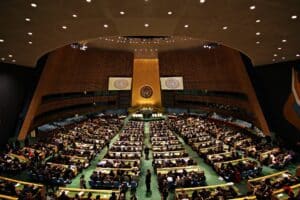General elections are set to take place in Hungary during the spring of 2022, which could potentially see Prime Minister Victor Orbán’s Fidesz lose its majority. For the first time since 2010 the opposition stands a fighting chance. This is the result of the six largest opposition parties agreeing to form a coalition in December of 2020. More recently, Budapest’s mayor Gergely Karacsony accepted his party’s nomination as leader in the run up to the 2022 elections. A first and second informal vote within the united opposition will determine who is to challenge Orbán during the election. It seems as Orbán is both exploring ways to prevent an election loss, as well as to consolidate his power in the long run, in case of a potential defeat.
Opposition parties will fail unless they unite
In December of 2020, the six largest opposition parties declared to form a joint opposition against Orbán. It was agreed upon to put forward a single prime minister candidate, write a combined election manifesto, as well as to work towards a joint list of national candidates and joint candidates in the 106 constituencies. All of this will prove to be crucial if the United Opposition hopes to topple Orbán’s rule. Hungary’s election system heavily favours larger parties, with half of the parliament’s seats being assigned through the winner-take-all system. Winning enough of the 106 constituencies will be the United Opposition’s biggest challenge
The elections are expected to be centred around recovering the country’s economy after the COVID-19 pandemic. However, most of all the polls are marked by the United Opposition challenging Orbán, which can be considered a standoff between the cities and the countryside. Orbán relies on the support of a rather monolithic voter base, mostly living in rural areas. This voter base fully supports Fidesz on all of its policies and will be near impossible to be swayed. Many undecided voters remain though, which will prove crucial for the United Opposition. In the cities such as Budapest, the United Opposition is expected to enjoy widespread support.
Polls predict the tightest election race since 2006, with Fidesz and the United Opposition both poling at 48% currently. However, it is geography that will determine the result, not votes necessarily. Like in previous elections, gerrymandering is expected to occur. This redrawing of voter district border to gain an (unfair) advantage will prove to be Fidesz’s trick card. As the United Opposition can count on strong support in urban areas, for example outscoring Fidesz with 52% to 30% in Budapest, winning the proportional vote with slim margins will not win them a majority. The United Opposition are expected to need a 3-4% margin if it wants to beat Fidesz.
United Opposition hope for 2019 local election repeat
The United Opposition will hold two rounds of unofficial elections, like with the Democratic Party in the United States (US), to determine who is their shared candidate for Prime Minister. Near the end of September 2021 the first round will be held, with the second one only needed if none of the proposed candidates receive over 50% of the votes. Andras Fekete-Gyor, Peter Jakab, Peter Marki-Zay, Jozsef Palinkas and Klare Dobrev have all announced they would be running. However, Karacsony, the mayor of Budapest, is the United Opposition’s most likely prime ministerial candidate. He can already count on the support of two out of six opposition parties.
The 45-year old pollster turned politician dealt a strong blow to Orbán, when he managed to unseat Fidesz’s incumbent mayor of Budapest during the 2019 local elections. The opposition parties united behind quite some other candidates in the local elections too, which proven successful for them. With opposition wins in many municipalities, the elections proved a turning point, showing that a Fidesz win was not a given fact. Back then, the liberal-green mayor Karacsony, supported by the Socialists and green LMP party, was already considered the least objectionable candidate. Karacsony had up until now rejected facing Orbán though.
Finally, in a statement released last week, Karacsony declared he would be running for prime ministerial candidate for the United Opposition. When asked how he distinguished himself from Orbán, he controversially responded with: “Orbán is short and fat, and I am tall and slim”. More importantly, however, Karacsony declared that he made this decision because he believed his homeland was in “big trouble”. He also officially launched his own movement, which he called “Movement”. According to him the privileged 1% of the people in Hungary rule over the 99% of others. The liberal politician and academic can count on much of the young urban vote.
Personal attacks set tone for upcoming elections
Fearing the challenge that a potential Karacsony-led United Opposition could face to Fidesz during the upcoming elections, the counterattack was initiated immediately. Right after Karacsony’s controversial statements about Orbán’s size, the media released a barrage of criticism on Karacsony lack of adequate English skills. Karacsony mostly uses an English interpreter when having to speak in English. Such an attack on other prime ministerial candidates will follow. Orbán’s government will use its state media to sketch a biased image of the political situation, which happened during the 2018 parliamentary elections too.
The 2022 election are also set to be characterized again by a vague distinction between the state and the Fidesz party. The state’s resources are likely to be used in many ways to undermine the United Opposition, of which gerrymandering will be an example. Another challenge for the opposition will be to initiate genuine political debate, so that voters can make an informed decision. However, the tone is already set for the campaign to become personal instead, given Karacsony’s comments in one of his first interviews. It could be wiser to focus on policies and Orbáns weak handling of Hungary’s third COVID-19 wave, which saw the country become the world’s hardest struck country with the highest amount of death per capita.
Challenges stack against the United Opposition
Would the United Opposition indeed manage to break Orbán’s rule, the following phase might prove even more challenging. Governing with six parties together is complicated enough by itself, but dismantling Fidesz’s “deep state” will be even more difficult. Fidesz-loyal political appointees will remain in their posts, such as the governor of the central bank and president of the Supreme Court. Filling their shoes and reversing any of the alterations in the constitution would require a two-thirds majority, which the United Opposition seems unlikely to receive. Moreover, some analysts even predict that Fidesz would sabotage the new government.
Orbán is also thinking long term, hoping to attract more younger voters. By installing some controversial bills recently, Orbán hoped to gain more control over the education system. Many of the country’s universities have now become funded via foundations, of which his government will appoint the board of trustees. After gaining political and economic power, the Orbán government makes no secret of hoping to gain “intellectual power” too. Perhaps frustratingly, these foundations are financed with billions of dollars of European Union (EU) funds. To change back such developments, the new government would also need a two-thirds majority.
Considering that the budgets of municipalities in which Orbán lost during the 2019 local elections have been cut in several instances, a possible easy transfer of power, in case the six parties could win the elections, also remains farfetched. The challenges stack against the United Opposition, but the opposition parties have had the momentum since the successful 2019 local elections. They are looking up. If the opposition manage to beat Orbán remains to be seen, but it would already be a huge improvement to strip Fidesz of its two-thirds majority in parliament, which has allowed it to repeatedly alter the constitution and side-line the opposition. In turn, this could be an important step in putting stop to Hungary’s backsliding on democracy.
Image: Wikimedia (Gergely Karacsony, 2019)
Sources: BalkanInsight, Dw1, Dw2 Euractiv1, Euractiv2 Intellinews1, Intellinews2, Reuters1, Reuters2, Politico



